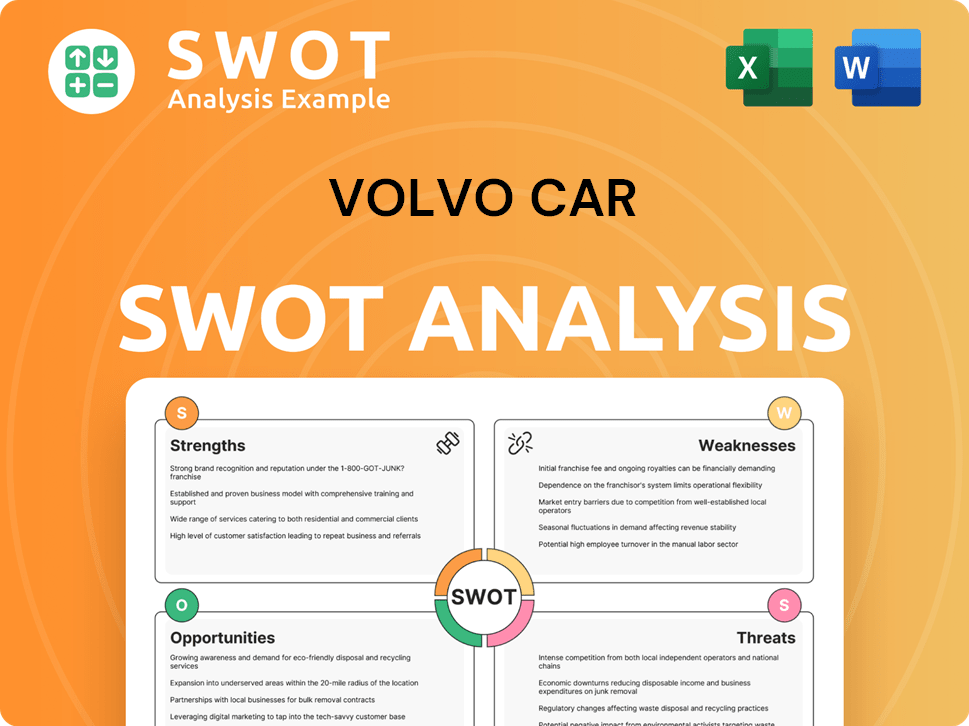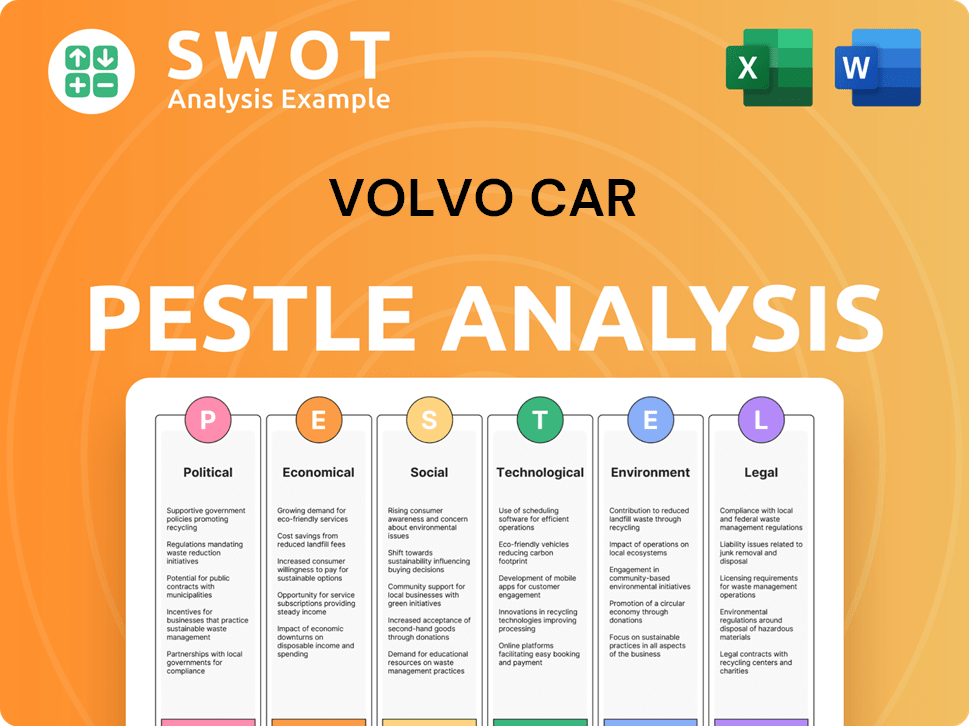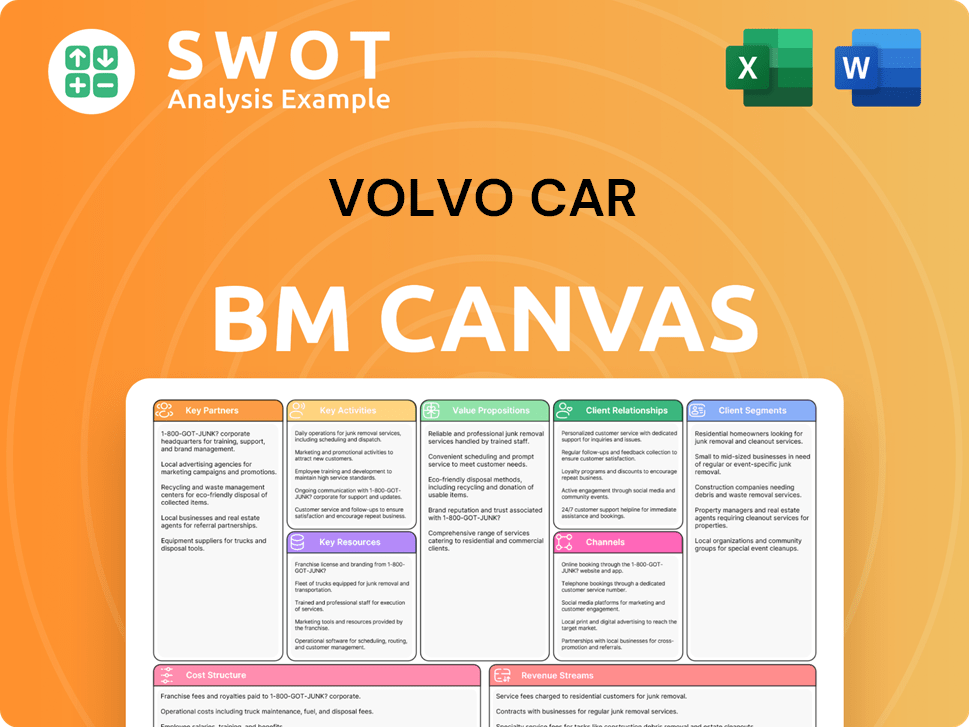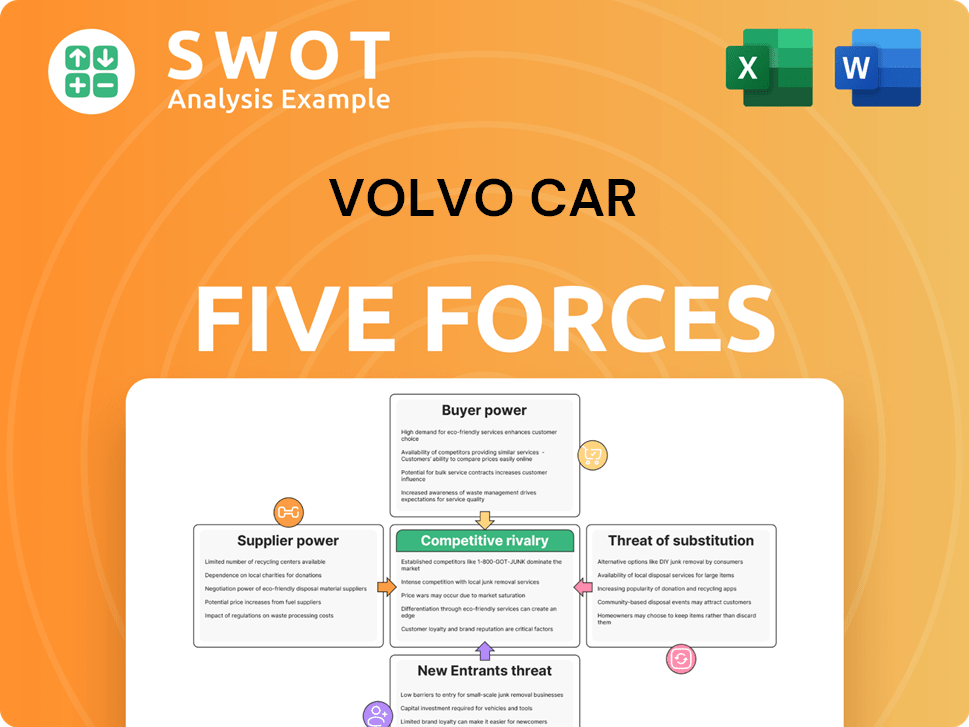Volvo Car Bundle
How Does Volvo Navigate the Cutthroat Automotive Arena?
Volvo Car Company, a stalwart in the luxury vehicle segment, faces a dynamic automotive industry. With its deep-rooted commitment to safety and a history dating back to 1927, Volvo has consistently evolved. Its journey from Swedish roads to a global presence, marked by strategic ownership changes, sets the stage for a critical look at its competitive environment.

This exploration delves into the Volvo Car SWOT Analysis, examining its position within the Volvo competitive landscape. We'll dissect its key Volvo car competitors, competitive advantages, and strategies for navigating the automotive industry competition, including the burgeoning electric vehicle market. Furthermore, we'll conduct a comprehensive Volvo market analysis to understand how it stacks up against luxury car brands and adapts to evolving consumer preferences.
Where Does Volvo Car’ Stand in the Current Market?
The Growth Strategy of Volvo Car positions itself within the global luxury vehicle market, distinguished by its association with safety, sustainability, and Scandinavian design. This focus helps define its market position amidst the competitive landscape.
In 2023, Volvo reported record full-year sales, with 708,716 cars sold globally, marking a 15% increase compared to 2022. This growth underscores the company's ability to compete effectively in the automotive industry competition.
Volvo's primary product lines include sedans, station wagons, and a strong emphasis on SUVs such as the XC40, XC60, and XC90, which contribute significantly to sales volume. The company has strategically shifted towards a fully electric future, aiming for 50% of its sales to be fully electric cars by 2025 and to be a fully electric car company by 2030, thus entering the electric vehicle market.
While specific 2024-2025 global market share figures are still emerging, Volvo has shown consistent growth in key markets. The company's performance in Europe, the US, and China, its three largest sales regions, is a key indicator of its competitive standing.
Volvo's product range includes sedans, station wagons, and a strong focus on SUVs. The strategic shift towards electric vehicles, targeting a fully electric lineup by 2030, is a key aspect of its future plans for electric vehicle competition.
Volvo's financial health, as evidenced by robust sales figures and increasing profitability, positions it favorably against industry averages. Its geographic presence is strong across North America, Europe, and Asia, with notable growth in the Chinese market under Geely's ownership.
Volvo's emphasis on safety, sustainability, and Scandinavian design provides competitive advantages. Key challenges include adapting to changing consumer preferences and the impact of competitors like Tesla in the luxury car market.
Volvo's market position is defined by its brand image, product portfolio, and strategic focus on electric vehicles. This includes adapting to the competitive landscape of Volvo car competitors.
- Strong brand association with safety and sustainability.
- Growing sales in key markets like Europe, the US, and China.
- Strategic shift towards a fully electric vehicle future.
- Focus on SUVs, such as the XC40, XC60, and XC90.
Volvo Car SWOT Analysis
- Complete SWOT Breakdown
- Fully Customizable
- Editable in Excel & Word
- Professional Formatting
- Investor-Ready Format

Who Are the Main Competitors Challenging Volvo Car?
The competitive landscape for the automotive industry is intense, especially within the luxury segment where the company operates. Understanding the key players and their strategies is crucial for assessing its market position and future prospects. This analysis delves into the major competitors, their strengths, and the challenges they pose.
The company faces a multifaceted competitive environment, encompassing both direct and indirect rivals. Direct competitors include established luxury brands, while indirect competition comes from emerging electric vehicle (EV) specialists and other automakers. The company's ability to navigate this complex landscape will significantly impact its success.
The luxury automotive market is highly competitive, with the company facing established rivals and emerging competitors. The company's success depends on its ability to differentiate itself through product offerings, brand positioning, and strategic partnerships. The competitive landscape is constantly evolving, driven by technological advancements, changing consumer preferences, and global economic conditions.
The primary direct competitors include premium German automakers like BMW, Mercedes-Benz, and Audi. These brands compete on brand prestige, technological innovation, and global distribution. They offer a wide range of vehicles, including sedans, SUVs, and high-performance models.
BMW reported global sales of 2,555,341 units in 2023, including the BMW, MINI, and Rolls-Royce brands. This demonstrates BMW's substantial market presence and scale in the luxury automotive sector.
Mercedes-Benz reported strong sales in 2023, with 2,043,800 units sold by its Cars division. This highlights Mercedes-Benz's strong position in the global luxury car market.
Audi delivered 1.895 million cars to customers in 2023, showcasing its strong market presence. Audi's sales figures reflect its competitive standing in the premium car segment.
Lexus and Acura are also significant competitors, particularly known for their reliability and customer service. These brands often appeal to consumers seeking dependable and high-quality vehicles.
Tesla, as an indirect competitor, poses a significant challenge, especially in the premium EV segment. Tesla delivered 1.81 million vehicles in 2023, highlighting its substantial market share in the EV space.
The company must also contend with emerging Chinese luxury brands, particularly in the Chinese market. These brands leverage local manufacturing advantages and rapid technological advancements. The competitive landscape is also influenced by collaborations, such as the increasing partnerships between traditional automakers and tech companies to develop advanced automotive software and autonomous driving capabilities. To learn more about how this company approaches the market, you can read about the Marketing Strategy of Volvo Car.
The company faces several challenges in this competitive landscape. These include aggressive pricing strategies from competitors, rapid innovation in infotainment and autonomous driving, and the strong brand loyalty of established rivals. The company's ability to meet these challenges will be critical for its future success.
- Aggressive pricing strategies by competitors.
- Rapid innovation in infotainment and autonomous driving systems.
- Strong brand loyalty among customers of established competitors.
- Extensive global dealership networks of competitors.
- Continuous advancements in electric powertrain technology.
Volvo Car PESTLE Analysis
- Covers All 6 PESTLE Categories
- No Research Needed – Save Hours of Work
- Built by Experts, Trusted by Consultants
- Instant Download, Ready to Use
- 100% Editable, Fully Customizable

What Gives Volvo Car a Competitive Edge Over Its Rivals?
The competitive landscape for Volvo Car Company is shaped by its distinct strengths and strategic positioning within the automotive industry. Key milestones and strategic moves, such as its commitment to electrification and sustainable practices, have significantly influenced its competitive edge. Volvo's focus on safety, design, and technology, coupled with its strategic partnerships, allows it to navigate the dynamic challenges of the automotive market.
Volvo's commitment to innovation and sustainability is a core element of its strategy. The company's focus on electric vehicles and sustainable manufacturing processes aligns with the growing consumer demand for environmentally responsible products. This approach, backed by its parent company, Geely Holding, provides the resources needed to compete effectively in the evolving automotive market.
Analyzing the Volvo competitive landscape reveals a company that leverages its brand identity and strategic partnerships to maintain its position in the automotive industry competition. This approach allows it to compete effectively in the premium car segment and adapt to changing consumer preferences.
Volvo's long-standing reputation for safety is a significant competitive advantage. This is supported by continuous innovation in safety features and technologies. The company's commitment to safety has driven significant advancements in active and passive safety systems, setting industry benchmarks.
Volvo's strong brand equity, particularly in markets that value responsible consumption, is a key advantage. Its focus on electrification and sustainability resonates with environmentally conscious buyers. This is a crucial factor in the electric vehicle market, where consumer preferences are shifting towards sustainable options.
The partnership with Geely Holding provides access to capital, shared platforms, and economies of scale. This strategic alliance allows Volvo to accelerate its technological development, especially in electric vehicle architecture and autonomous driving. This partnership is a key element in Volvo's ability to compete effectively.
Volvo's Scandinavian design philosophy, which emphasizes minimalist aesthetics and functionality, sets it apart. This design approach appeals to a specific customer segment seeking understated luxury. This distinct design philosophy enhances its brand identity and market positioning.
Volvo's competitive advantages are built on its strong brand reputation, commitment to sustainability, and strategic partnerships. These factors enable Volvo to compete effectively in the luxury car brands market. The company’s focus on innovation and customer-centric design further strengthens its position.
- Safety Leadership: Volvo's legacy of safety innovation continues to differentiate it.
- Sustainability Focus: Commitment to electrification and sustainable practices attracts environmentally conscious consumers. Volvo aims for 50% pure electric car sales by 2025.
- Strategic Partnerships: Geely Holding provides crucial resources for technological advancement.
- Design Philosophy: Scandinavian design offers a unique appeal in the luxury market.
To understand more about Volvo's financial performance and business model, you can read about the Revenue Streams & Business Model of Volvo Car.
Volvo Car Business Model Canvas
- Complete 9-Block Business Model Canvas
- Effortlessly Communicate Your Business Strategy
- Investor-Ready BMC Format
- 100% Editable and Customizable
- Clear and Structured Layout

What Industry Trends Are Reshaping Volvo Car’s Competitive Landscape?
The automotive industry is undergoing a period of significant transformation, with the rise of electric vehicles (EVs), autonomous driving technologies, and evolving consumer preferences reshaping the competitive landscape for companies like Volvo. This evolution presents both considerable opportunities and potential challenges. Analyzing the Volvo competitive landscape requires understanding these trends and their impact on the company's strategic positioning.
Key risks include the rapid pace of technological change, intense competition from both traditional automakers and new entrants in the electric vehicle market, and the need for substantial investments in research and development. The future outlook for Volvo depends on its ability to adapt to these changes, leverage its strengths, and capitalize on emerging opportunities within the premium automotive sector.
The automotive industry is increasingly focused on electrification, with a growing demand for EVs. Autonomous driving technologies are advancing rapidly, and consumer preferences are shifting towards connected car features and subscription-based services. These trends are influencing the strategies of all major players, including those in the luxury car brands segment.
Key challenges include the high costs associated with EV development and battery production, along with the need to establish robust charging infrastructure. There's also the need to navigate complex regulatory environments and address ethical considerations related to autonomous driving. Competition is fierce, with established automakers and new EV manufacturers vying for market share.
Volvo can leverage its strong brand reputation for safety and sustainability to attract environmentally conscious consumers. Expanding its EV portfolio and investing in charging solutions can strengthen its position in the growing EV market. Strategic partnerships and exploring new mobility services can also unlock new revenue streams.
Volvo is focusing on a fully electric lineup by 2030 and investing in autonomous driving technologies. Partnerships with technology companies are crucial for software and autonomous driving development. Exploring subscription models and connected car services are also part of its strategic initiatives. For more information on the company's target market, see the Target Market of Volvo Car.
To succeed, Volvo must effectively manage its transition to EVs while maintaining its brand identity. It needs to address rising raw material costs for batteries and strengthen its supply chain. Furthermore, Volvo must continue to innovate in safety and technology to stay ahead of the competition in the automotive industry competition.
- Electric Vehicle Transition: The shift to EVs is critical, with 68% of Volvo's global sales being electrified in 2023.
- Technological Advancements: Investing in autonomous driving and connected car features is essential.
- Market Expansion: Targeting key markets like China and Europe, where EV adoption is growing rapidly.
- Competitive Pricing: Maintaining a competitive pricing strategy against rivals like Tesla and BMW is important.
Volvo Car Porter's Five Forces Analysis
- Covers All 5 Competitive Forces in Detail
- Structured for Consultants, Students, and Founders
- 100% Editable in Microsoft Word & Excel
- Instant Digital Download – Use Immediately
- Compatible with Mac & PC – Fully Unlocked

Related Blogs
- What are Mission Vision & Core Values of Volvo Car Company?
- What is Growth Strategy and Future Prospects of Volvo Car Company?
- How Does Volvo Car Company Work?
- What is Sales and Marketing Strategy of Volvo Car Company?
- What is Brief History of Volvo Car Company?
- Who Owns Volvo Car Company?
- What is Customer Demographics and Target Market of Volvo Car Company?
Disclaimer
All information, articles, and product details provided on this website are for general informational and educational purposes only. We do not claim any ownership over, nor do we intend to infringe upon, any trademarks, copyrights, logos, brand names, or other intellectual property mentioned or depicted on this site. Such intellectual property remains the property of its respective owners, and any references here are made solely for identification or informational purposes, without implying any affiliation, endorsement, or partnership.
We make no representations or warranties, express or implied, regarding the accuracy, completeness, or suitability of any content or products presented. Nothing on this website should be construed as legal, tax, investment, financial, medical, or other professional advice. In addition, no part of this site—including articles or product references—constitutes a solicitation, recommendation, endorsement, advertisement, or offer to buy or sell any securities, franchises, or other financial instruments, particularly in jurisdictions where such activity would be unlawful.
All content is of a general nature and may not address the specific circumstances of any individual or entity. It is not a substitute for professional advice or services. Any actions you take based on the information provided here are strictly at your own risk. You accept full responsibility for any decisions or outcomes arising from your use of this website and agree to release us from any liability in connection with your use of, or reliance upon, the content or products found herein.